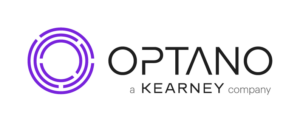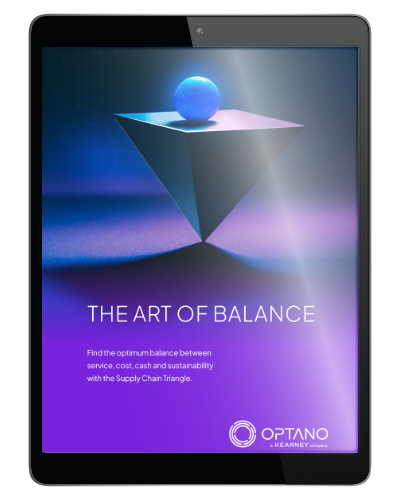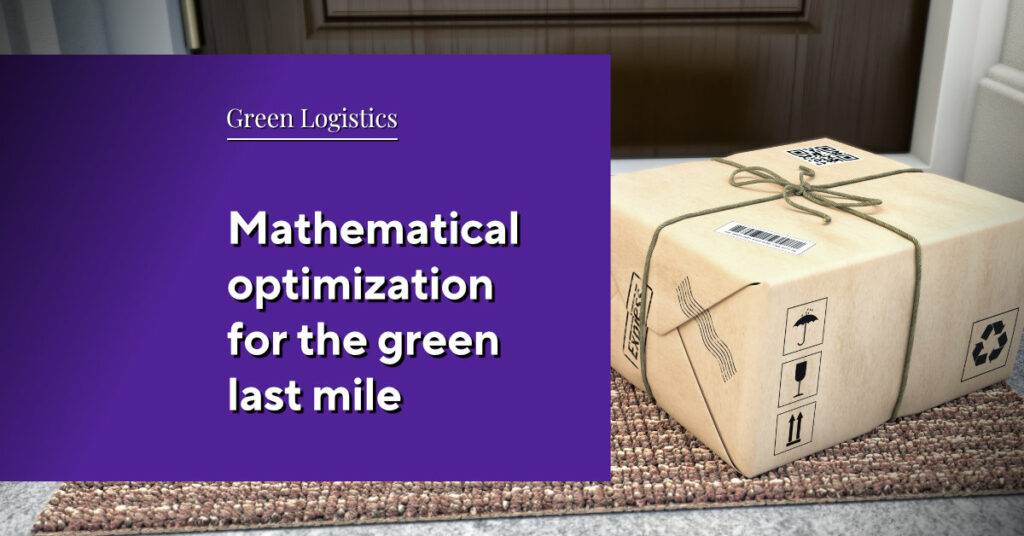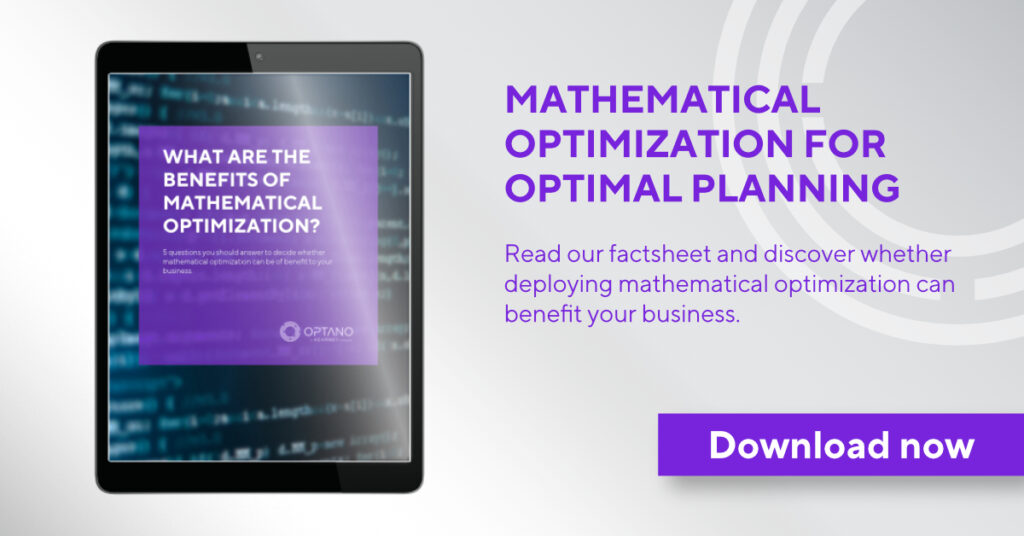Supply Chain Triangle: Balancing costs and service level
In today’s competitive business environment, an efficient supply chain represents a critical strategic advantage. Organizations face constant pressure to deliver products to customers more quickly, cost-effectively, and reliably. However, these objectives often conflict with one another. For instance, reducing costs may lead to longer delivery times, while enhancing service levels typically requires maintaining higher inventory levels. This inherent tension is encapsulated in the concept of the Supply Chain Triangle — a classic trade-off between cost, service level, and working capital (cash flow).
Many organizations face a critical challenge: how to strike the right balance between competing supply chain objectives without permanently compromising one of them. In this article, we explore how companies are leveraging mathematical optimization — specifically through the OPTANO solution for network optimization — to successfully resolve the tension between cost efficiency and service level, achieving remarkable results in the process.
Complexity in the Supply Chain Triangle: cost efficency versus service level
The Supply Chain Triangle is not just a theoretical framework — it is a daily operational reality for supply chain planners. Every decision, whether related to warehousing, transportation logistics, or network design, impacts at least two of the three key performance dimensions. For example, lowering inventory levels may reduce costs but increases the risk of supply disruptions. Conversely, enhancing service levels through greater product availability typically leads to higher storage and transportation expenses.
These conflicting objectives are further exacerbated by external factors.
- Global supply chains with extended transportation routes and geopolitical risks
- Volatile markets with highly fluctuating demand
- Growing customer expectations for rapid delivery and end-to-end transparency
- Sustainability requirements introducing new regulatory and operational constraints
To manage this increasing complexity, many companies still rely on traditional tools such as Excel. However, these tools quickly reach their limits when it comes to optimizing multiple objectives simultaneously while accounting for thousands of variables and constraints. The consequence? Decisions are often driven by intuition or isolated KPIs — resulting in limited effectiveness and missed opportunities.
Intelligent planning in the supply chain triangle: balancing trade-offs with precision
As previously outlined, the Supply Chain Triangle clearly demonstrates that companies consistently face trade-offs between cost, service level, and cash flow during the planning process. It is therefore essential to identify the optimal balance, manage it deliberately, and base decisions on robust data insights.
Modern technologies — such as mathematical optimization — bring transparency to these complex interdependencies and enable companies to leverage them strategically. By understanding the specific impact of each decision on the supply chain, companies can implement measures that are both economically sound and aligned with service objectives
More interesting articles
Mathematical optimization with OPTANO
OPTANO provides companies with a powerful, mathematics-based optimization solution for enhancing supply chain performance. Unlike traditional approaches, the OPTANO solution for network optimization simultaneously considers all relevant influencing factors and target metrics. The software evaluates millions of potential scenarios and determines the optimal solution — taking into account capacities, costs, lead times, sustainability goals, and more.
Beyond operational planning, the OPTANO solution for network optimization supports companies in aligning their supply chain strategies with long-term, future-oriented goals. The software enables strategic evaluations such as selecting new warehouse locations, introducing alternative transportation routes, or transitioning to more sustainable delivery models. By incorporating external variables — such as market dynamics, geopolitical risks, and regulatory requirements — companies can make well-informed, data-driven decisions about long-term investments. This leads to more efficient, agile, and resilient supply chains.
Ultimately, companies can elevate their planning processes from reactive to strategic — gaining a competitive edge in an increasingly complex environment.
OPTANO in practice
Supply chain optimization in retail: Lower costs and satisfied customers
Drawing on the success of past projects, we would like to present a practical example of how our planning software enables companies to effectively navigate the challenges and complexities of modern supply chain management.
A leading retail company faced the urgent need to enhance the efficiency of its supply chain. Over time, its network structures had become outdated and no longer aligned with evolving market demands. Prolonged lead times, excessive inventory levels, and escalating logistics costs were undermining the company’s competitiveness.
By leveraging the OPTANO solution for network optimization, the company conducted a comprehensive analysis and redesign of its supply chain. This included re-evaluating warehouse locations, optimizing transportation routes, and refining inventory strategies to better align with current and future business requirements.
The result:
Lead times were reduced by 50%.
Logistics costs decreased by 12%.
Significant gains in efficiency and cost-effectiveness were achieved.
Notably, these improvements were realized without compromising service levels. On the contrary, customer satisfaction increased as a result of faster product availability.
Optimal trade-offs and a perfect balance
Every day, companies are required to make decisions that impact costs, service levels, and cash-flow navigating complex interdependencies and external pressures. The Supply Chain Triangle underscores a fundamental truth: there is no one-size-fits-all solution. However, there are smarter, more effective ways to manage competing objectives.
The OPTANO solution for network optimization equips companies with a powerful tool to address these challenges. Real-world use cases demonstrate how mathematical optimization can resolve seemingly conflicting goals and drive holistic improvements across the supply chain. Companies that invest in intelligent, data-driven planning today are positioning themselves for a decisive competitive advantage tomorrow.
Would you like to learn how your company can successfully navigate the supply chain triangle? Contact us to learn how OPTANO can optimize your supply chain for efficiency, cost-effectiveness, and service. Stay informed by downloading our detailed fact sheet on this topic.
Have you already got our factsheet on this topic?
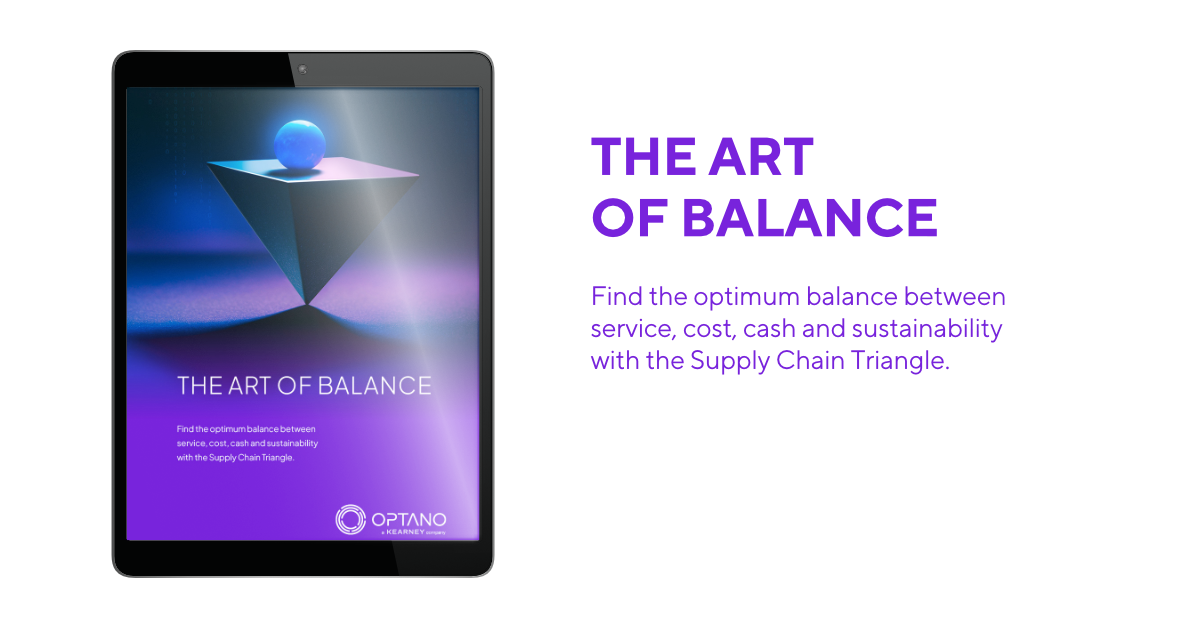
In today’s dynamic business environment, companies are under constant pressure to enhance the efficiency, cost-effectiveness, and resilience of their supply chains. Yet, pursuing all these objectives simultaneously can quickly become a complex challenge.
This is where the Supply Chain Triangle becomes essential. Our fact sheet provides valuable insights into how to effectively balance service levels, costs, cash flow, and sustainability — enabling you to make strategic decisions and build a future-ready supply chain.
To obtain our factsheet, all you need to do is enter your contact details in the space below. A pop-up window will then open to download the whitepaper. Please note that by providing us with your email address, you agree that we may contact you on this topic. You may revoke this agreement at any time by contacting privacy@optano.com.
